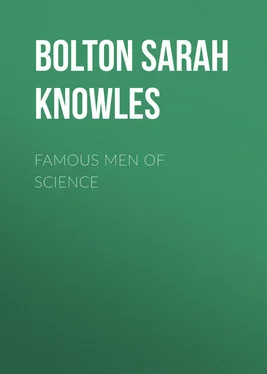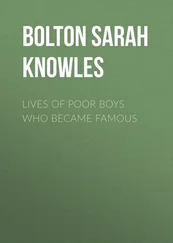Sarah Bolton - Famous Men of Science
Здесь есть возможность читать онлайн «Sarah Bolton - Famous Men of Science» — ознакомительный отрывок электронной книги совершенно бесплатно, а после прочтения отрывка купить полную версию. В некоторых случаях можно слушать аудио, скачать через торрент в формате fb2 и присутствует краткое содержание. ISBN: , Жанр: foreign_language, foreign_antique, foreign_prose, Биографии и Мемуары, на английском языке. Описание произведения, (предисловие) а так же отзывы посетителей доступны на портале библиотеки ЛибКат.
- Название:Famous Men of Science
- Автор:
- Жанр:
- Год:неизвестен
- ISBN:http://www.gutenberg.org/ebooks/35489
- Рейтинг книги:3 / 5. Голосов: 1
-
Избранное:Добавить в избранное
- Отзывы:
-
Ваша оценка:
- 60
- 1
- 2
- 3
- 4
- 5
Famous Men of Science: краткое содержание, описание и аннотация
Предлагаем к чтению аннотацию, описание, краткое содержание или предисловие (зависит от того, что написал сам автор книги «Famous Men of Science»). Если вы не нашли необходимую информацию о книге — напишите в комментариях, мы постараемся отыскать её.
Famous Men of Science — читать онлайн ознакомительный отрывок
Ниже представлен текст книги, разбитый по страницам. Система сохранения места последней прочитанной страницы, позволяет с удобством читать онлайн бесплатно книгу «Famous Men of Science», без необходимости каждый раз заново искать на чём Вы остановились. Поставьте закладку, и сможете в любой момент перейти на страницу, на которой закончили чтение.
Интервал:
Закладка:
He also made a water clock, about four feet high, with a dial-plate at the top, with figures of the hours. The index was turned by a piece of wood, which either fell or rose by water dropping. Every morning the lad supplied his clock with the proper amount of water.
Besides these, he invented a four-wheeled carriage, which was moved with a handle by the person who sat in it. For his boy friends, he made lanterns of "crimpled paper" with a candle inside, to light them to school in the dark winter mornings, and paper kites of the best form and proportion. In dark nights he tied the lanterns to the tails of his kites, and ignorant people sometimes mistook them for comets!
On the manor-house at Woolsthorpe he carved sun-dials, which were visible a century later. He was a "sober, silent, and thinking lad," who was always hammering in his room, or making drawings with his pen and pencil, designing with charcoal on his walls, birds, animals, ships, and mathematical diagrams.
Mrs. Newton, the mother, had married again, after a singular courtship. "Mr. Smith, a neighboring clergyman, who had a very good estate, had lived a bachelor till he was pretty old, and, one of his parishioners advising him to marry, he said he did not know where to meet with a good wife. The man answered, 'The widow Newton is an extraordinary good woman.' 'But,' said Mr. Smith, 'how do I know she will have me, and I don't care to ask and be denied; but if you will go and ask her, I will pay you for your day's work.'
"He went accordingly. Her answer was, she would be advised by her brother Ayscough, upon which Mr. Smith sent the same person to Mr. Ayscough on the same errand, who, upon consulting with his sister, treated with Mr. Smith, who gave her son Isaac a parcel of land, one of the terms insisted upon by the widow if she married him."
Though for a time she was thus removed from Isaac, leaving him with his grandmother, on the death of Rev. Mr. Smith, she returned to the manor-house.
When Isaac had reached his fifteenth year, his mother, not seeming to think of any profession for her mechanical son, decided to make of him a farmer and grazier. On Saturdays, the market day at Grantham, she would send him with grain and other agricultural produce, in the care of an old and trusty servant. The boy had no taste for selling produce, and would hasten to the attic in the house of Mr. Clark, an apothecary, with whom he had boarded while at school, and there spend his hours in reading old books, till the time came for him to go home, the servant meantime having sold the vegetables.
Sometimes, however, the lad would not go as far as Grantham, but, seating himself beside a hedge along the road, would read some favorite author till the servant returned. When his mother sent him to watch the cattle, they enjoyed a neighbor's corn-field, while he enjoyed a book or whittled out water-wheels. It did not seem intentional disobedience toward a mother of whom he was very fond, but complete absorption in some other pursuit.
When he was sixteen he was greatly interested in finding the proper form of a body which would offer the least resistance when moving in a fluid. In a severe storm, to test the force of the gale, he jumped first in the direction in which the wind blew, and then in opposition to the wind, and after measuring the length of the leap in both directions, and comparing it with the length to which he could jump in a perfectly calm day, he was enabled to compute the force of the storm.
His mother soon found that her boy would not make a successful farmer, and sent him back to school at Grantham, to prepare for Trinity College, Cambridge, which he entered when he was nineteen.
It is probable that the time spent at Grantham was a happy time; for young Newton there met and, it is said, loved Miss Storey, sister of Dr. Storey, a physician near Colsterworth, and daughter of the apothecary's second wife. She was two or three years younger than Newton, a girl of attractive face and unusual talents. As his income as a Fellow was small, after leaving college, they did not marry, though his interest in her continued unabated through life. Though she was twice married, he never paid a visit to Woolsthorpe without going to see her, and liberally relieved her from little pecuniary embarrassments, when his own circumstances had become easy. How the world loves constancy; an affection which knows no change! That he would have been happier in those quiet years of study, even in his poverty, had he married, is probable; but that the world gained by his undivided devotion to science, is equally probable.
On July 8, 1661, Newton entered college, and soon, through the study of Descartes' Geometry, showed his skill in higher mathematics. And now began an almost unexampled development of mind.
At twenty-two, he was studying a comet so closely, and the circles and halo round the moon, that he impaired his health by sitting up late at night. In 1665, May 20, when he was twenty-three, he committed to writing his first discovery of fluxions – "the infinitely small increase or decrease of a variable or flowing quantity in a certain infinitely small and constant period of time."
The same year, when the college had been dismissed on account of the plague in Cambridge, Newton made his immortal discovery of the Attraction of Gravitation. While sitting alone in his garden at Woolsthorpe, and observing an apple fall to the ground, it occurred to him that as the same power by which the apple fell was not sensibly diminished at the summits of the loftiest spires, nor on the tops of the highest mountains, it might extend to the moon, about which he had been studying, and retain her in her orbit. If to the moon, why not to the planets?
The tree from which the apple fell was so much decayed in 1820, that it was cut down, but the wood was carefully preserved by Mr. Turnor of Stoke Rocheford.
In the beginning of the following year, 1666, when Newton was twenty-four, he purchased a prism, in order to make some experiments on Descartes' theory of colors. He made a hole in his window shutter, darkened the room, and admitted a ray of the sunlight. On the opposite wall he saw the solar or prismatic spectrum, an elongated image of the sun, about five times as long as it was broad, and consisting of seven different colors; red, orange, yellow, green, blue, indigo, and violet. White light was thus discovered to be of a compound nature; a mixture of all the colors. He said, "Whiteness is the usual color of light; for light is a confused aggregate of rays endued with all sorts of colors, as they are promiscuously darted from the various parts of luminous bodies." If any one color predominates, the light will incline to that color, as the yellow flame of a candle. Heretofore, there had been all sorts of conjectures about the nature and origin of colors. Descartes believed them to be a modification of light, depending on the direct or rotary motion of its particles. But Newton showed by many experiments that color is a property of light, or innate in light itself. We speak of a thing as red because it reflects red, and absorbs all the other colors. The green leaf stops or absorbs the red, blue, and violet rays of the white light, and reflects and transmits only those which compose its green.
He also found that the red rays are refracted or turned out of their course least of all the colors, and violet most, thereby discovering the different refrangibility of the rays of light; "a discovery which has had the most extensive applications to every branch of science, and, what is very rare in the history of inventions, one to which no other person has made the slightest claim."
His beautiful experiments with rings resulted in his Scale of Colors, of great value in optical research.
In 1668, when Newton was twenty-six, he constructed a small reflecting telescope, and soon a larger one, which he sent to the Royal Society; and was made a member of that body, in 1671. Two years previously he had been appointed to the Lucasian professorship of mathematics at Cambridge.
Читать дальшеИнтервал:
Закладка:
Похожие книги на «Famous Men of Science»
Представляем Вашему вниманию похожие книги на «Famous Men of Science» списком для выбора. Мы отобрали схожую по названию и смыслу литературу в надежде предоставить читателям больше вариантов отыскать новые, интересные, ещё непрочитанные произведения.
Обсуждение, отзывы о книге «Famous Men of Science» и просто собственные мнения читателей. Оставьте ваши комментарии, напишите, что Вы думаете о произведении, его смысле или главных героях. Укажите что конкретно понравилось, а что нет, и почему Вы так считаете.












